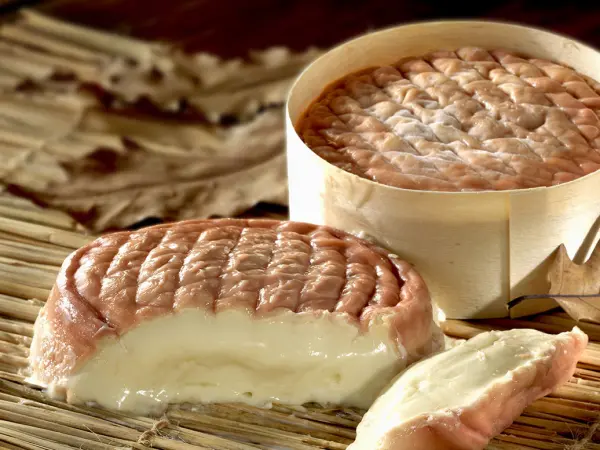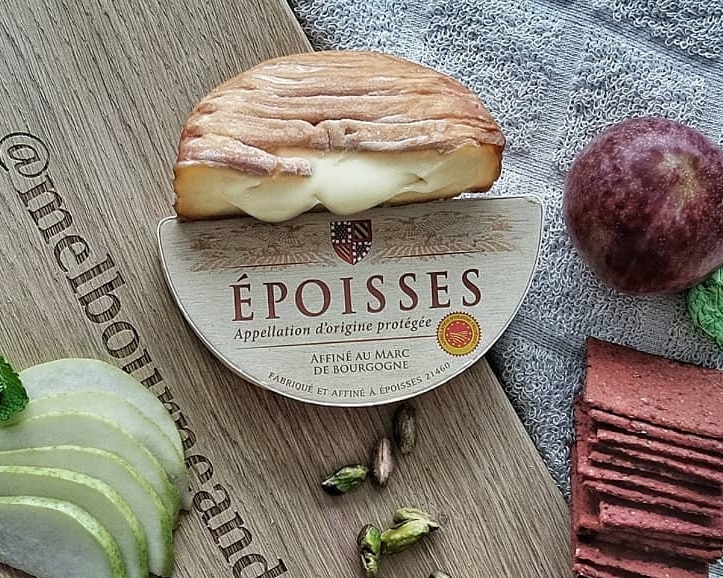What is Epoisses? The Pungent Pride of Burgundy

Epoisses, the pungent pride of Burgundy, is more than just a cheese. It’s a sensory journey into the heart of French gastronomy, a testament to centuries-old traditions, and a bold statement in flavor. This legendary cheese, hailing from the quaint village of Epoisses in the Burgundy region of France, has been captivating palates and stirring conversations since the 16th century.
With an aroma so robust it was once banned from French public transportation, Epoisses is not for the faint of heart. Yet, those who dare to delve into its creamy depths are rewarded with a rich, nuanced flavor that truly embodies the spirit of its homeland.
Quick Facts About Epoisses
| Quick Facts | Description |
|---|---|
| Country of Origin | France |
| Region | Burgundy |
| Made From | Cow’s milk |
| Type | Soft, washed-rind |
| Texture | Creamy, smooth, and slightly grainy |
| Color | Orange to reddish-brown |
| Aroma | Strong, pungent |
| Flavor | Salty, creamy with a hint of sweetness |
| Aging Time | 4-6 weeks |
| Best Paired With | Full-bodied red Burgundy wine, crusty baguette |
| Interesting Fact | Epoisses is so smelly that it’s banned from public transportation in France |
| Protected Designation | AOC (Appellation d’Origine Contrôlée) since 1991 |
| Availability | Year-round, but best between March and December |
| Substitutes | Langres, Munster |
| Serving Suggestions | Allow it to come to room temperature before serving to fully appreciate its flavor and texture. It’s typically served with a spoon due to its runny interior. |
What is Epoisses?

Delve into the world of Epoisses, a French cheese that is as notorious as it is beloved. Originating from the charming village of Epoisses in the Burgundy region of France, this cheese is renowned for its robust aroma and distinctive flavor profile – a testament to the area’s rich dairy farming heritage.
Epoisses is a soft, washed-rind cheese made from cow’s milk, boasting a creamy and slightly grainy texture that is simply irresistible. Its rind, with hues ranging from vibrant orange to reddish-brown, is the result of repeated washings in Marc de Bourgogne, a local brandy.
This process not only gives Epoisses its characteristic color but also contributes to its strikingly pungent aroma. Yes, Epoisses is famously fragrant, so much so that it’s even been banned on public transportation in France!
But don’t let its strong scent deter you. Beneath its formidable exterior lies a symphony of flavors. Epoisses offers a delightful balance of salty and sweet, with a rich, creamy taste that lingers on your palate. It’s a complex cheese that invites you to savor each bite slowly, appreciating the depth of its flavor.
Despite its bold characteristics, Epoisses is surprisingly versatile. It pairs beautifully with a full-bodied red Burgundy wine and a crusty baguette, making it a star attraction on any cheese platter. Whether you’re a seasoned cheese enthusiast or just beginning your journey into the world of Fromage, Epoisses promises an unforgettable tasting experience.
Protected by the AOC (Appellation d’Origine Contrôlée) designation since 1991, Epoisses is more than just a cheese; it’s a celebration of tradition, craftsmanship, and the unique flavors of the Burgundy region.
What Does Epoisses Taste Like?
Epoisses is a cheese that surprises many with its complex and robust flavor profile. Despite its powerful aroma, the taste of Epoisses is rich, creamy, and surprisingly well-balanced.
Upon the first bite, you’ll notice an initial salty tang, which is quickly followed by a profound creaminess. This decadent creaminess is one of Epoisses’ defining features, thanks to the high-fat content of the cow’s milk from which it’s crafted. As the cheese melts in your mouth, it releases subtle notes of sweet caramel and earthy umami, adding layers of complexity to its flavor.
The rind, washed in Marc de Bourgogne, contributes a slight alcoholic note to the cheese’s overall flavor. This hint of brandy combined with the cheese’s inherent flavors creates a unique, savory taste that lingers on the palate.
Epoisses is best enjoyed at room temperature, allowing its full range of flavors to be properly expressed. Its taste can also vary slightly depending on its age, with younger Epoisses being milder and less complex, while fully matured ones offer a deeper, more intense flavor experience.
Overall, Epoisses offers a delightful gastronomic journey, blending salty, sweet, and umami flavors in a creamy, melt-in-your-mouth texture. It’s a must-try for any cheese lover or food enthusiast.
Epoisses Tasting Notes

- Appearance: Epoisses has a distinctive look with its vibrant orange to reddish-brown rind. It is typically sold in a round wooden box and has a soft, creamy interior that can be quite runny at room temperature.
- Aroma: Known for its strong, pungent odor, Epoisses has a robust smell that can be described as barnyard-like or earthy. This powerful aroma is due to the washing of the rind in Marc de Bourgogne, a local brandy.
- Texture: Epoisses boasts a creamy, slightly grainy texture. As it matures, the cheese becomes softer and gooier, often requiring a spoon to serve.
- Flavor: Despite its intense aroma, Epoisses offers a surprisingly balanced flavor profile. It starts off with a salty tang, followed by a rich creaminess. Subtle notes of sweet caramel and earthy umami are also present, adding layers of complexity to the taste.
- Aftertaste: Epoisses leaves a lingering savory taste on the palate. The flavors deepen and become more complex with age, offering a memorable tasting experience.
- Pairing: Epoisses pairs well with full-bodied red Burgundy wines, which complement its rich, robust flavors. It also goes well with crusty bread or baguette, allowing the cheese’s creamy texture to really shine.
- Serving Suggestions: Epoisses is best enjoyed at room temperature to fully appreciate its flavor and texture. It’s typically served with a spoon due to its runny interior. It’s a great addition to any cheese board and can also be used in cooking to add a rich, creamy element to dishes.
Why is Epoisses Cheese Illegal?
The reputation of Epoisses cheese being “illegal” stems from two primary factors: its strong aroma and the U.S. regulations regarding raw milk cheeses.
Firstly, Epoisses is known for its potent smell, which has led to urban legends about its prohibition on public transportation in France, particularly the Paris Metro. However, this ban is more of a myth than a legal reality, and it’s more of a courtesy guideline to avoid disturbing other passengers with the cheese’s robust scent.
The second reason pertains to the United States regulation on cheese made from raw milk. The Food and Drug Administration (FDA) in the USA has set stringent rules for importing and selling raw milk cheeses, stating that they must be aged for 60 days or more to ensure food safety. Epoisses, particularly those made from raw milk, often don’t meet this requirement, leading to its effective ban in the U.S.
Therefore, while Epoisses isn’t technically “illegal” in the sense of being outlawed, its importation and sale in certain countries like the United States can be restricted due to food safety regulations. It’s always important to check local regulations when buying and consuming cheeses, especially those made from raw milk.
Is Epoisses similar to Camembert?
Epoisses and Camembert are both French cheeses that are renowned for their creamy textures and strong flavors. However, they have distinct differences that set them apart.
| Feature | Epoisses | Camembert |
|---|---|---|
| Origin | Burgundy, France | Normandy, France |
| Milk | Traditionally raw cow’s milk | Can be either raw or pasteurized cow’s milk |
| Rind and Aroma | Washed in Marc de Bourgogne brandy, orange-red rind, strong pungent aroma | White bloomy rind, strong but less potent aroma |
| Flavor | Salty start, creamy, caramel finish, deep and intense | Earthy, mushroom-like flavor, with a hint of nuttiness |
| Texture | Creamy, runny when fully matured | Creamy, maintains a bit more firmness |
- Origin: Epoisses is from the Burgundy region of France, while Camembert originates from Normandy.
- Milk: Both cheeses are traditionally made from cow’s milk. However, Epoisses is often made with raw milk (lait cru), while Camembert can be made from either raw or pasteurized milk. The type of milk used can significantly impact the flavor and texture of the cheese.
- Rind and Aroma: Epoisses has a distinctive orange-red rind, washed in Marc de Bourgogne brandy, which gives it a pungent aroma. Camembert, on the other hand, has a white bloomy rind and its smell, while strong, is less potent than that of Epoisses.
- Flavor: Epoisses has a robust, complex flavor profile with a salty start and a creamy, caramel finish. It’s often described as having a deep, intense, and slightly sweet flavor. Camembert, on the other hand, has a more earthy and mushroom-like flavor, with a hint of nuttiness.
- Texture: Both cheeses are known for their creamy, melt-in-your-mouth texture. Epoisses is typically runnier, especially when fully matured, while Camembert maintains a bit more firmness.
While there are similarities between Epoisses and Camembert, especially in terms of their creamy textures and strong flavors, they are unique cheeses with their own distinct characteristics.
>> Click here to read our in-depth guide on Camembert
How to Eat Epoisses?
Epoisses is a rich and creamy cheese that can be enjoyed in several ways. Here’s how you can savor this delightful cheese:
- Room Temperature: Like most cheeses, Epoisses should be served at room temperature. This allows the cheese to soften and its flavors to fully develop. Remove it from the refrigerator at least an hour before serving.
- Bread or Crackers: Epoisses pair well with crusty bread or neutral crackers. The cheese is quite runny when ripe, so it’s often eaten with a spoon or spread on bread.
- Food Pairings: Try pairing Epoisses with fruits like apples, pears, or grapes for a sweet contrast to its salty flavor. It also goes well with nuts and cured meats.
- Wine Pairing: A traditional Burgundy red wine or a white wine like Chardonnay pairs wonderfully with Epoisses. If you prefer beer, try a Belgian-style ale.
- Cooking: Epoisses can also be used in cooking. It’s great in gratins, on top of burgers, or melted into pasta. Just remember that its strong flavor can dominate, so use it sparingly.
- Tasting Order: If you’re serving multiple cheeses, save Epoisses for last. Its strong flavor can overwhelm the palate, making it harder to appreciate milder cheeses if eaten before them.
Remember, the strong aroma of Epoisses is part of its charm but might not be appreciated by everyone. So, you might want to warn any guests who are new to this type of cheese. Enjoy your cheese tasting!
5 Best Epoisses Substitutes
| Cheese | Description | Why It Works |
|---|---|---|
| Pont l’Eveque | A creamy and soft French cheese with a similar texture to Epoisses. It has a strong aroma but a mild flavor. | Its texture and aroma make it a great substitute for Epoisses, especially if you prefer a milder flavor. |
| Munster | This is a washed-rind cheese from France that shares a similar pungent aroma and soft texture with Epoisses. | Munster’s strong aroma and creamy texture make it a good match for Epoisses. |
| Limburger | A Belgian cheese with a strong smell and flavor. It’s also a washed-rind cheese with a similar consistency to Epoisses. | If you’re looking for a substitute with a potent aroma and flavor, Limburger could be the one. |
| Taleggio | An Italian cheese that’s also washed-rind. It has a strong smell but a relatively mild flavor. | Taleggio’s strong aroma and soft texture make it a good stand-in for Epoisses. |
| Livarot | Known as “The Colonel” in France, Livarot is a washed-rind cheese with a strong aroma and a soft, creamy texture. | Its potent smell and rich flavor profile make it a suitable alternative to Epoisses. |
What Pairs Well With Epoisses?

Food that goes well with Epoisses:
| Category | Food Pairings |
|---|---|
| Breads | Baguette, sourdough bread, rustic bread, and neutral crackers |
| Fruits | Apples, pears, dried fruits like figs and apricots, and grapes |
| Nuts | Walnuts, pecans, and almonds |
| Cured Meats | Prosciutto, salami, and other charcuterie |
| Preserves & Sweet Spreads | Fig jam, honey, or quince paste |
| Vegetables | Pickles, olives, radishes, and cherry tomatoes |
| Others | Dark chocolate for a unique combination |
Also read: What Fruit Goes on a Charcuterie Board?
Beverage that goes well with Epoisses:
| Category | Beverage Pairings |
|---|---|
| White Wine | Spicy Gewürztraminer, Champagne |
| Red Wine | Fruity Gamay, Mature Cru Beaujolais, Red Burgundy |
| Sparkling Wine | Blanc de Noir, Champagne Method Sparkling Wines |
| Fortified Wine | Fino Amontillado |
| Unique Suggestions | Pinot Noir with soft tannins and fruity aromas |
Also read: Best Wine and Cheese Pairings: The Ultimate Guide
Note: Epoisses has a strong flavor and aroma, so pairing it with beverages that can complement or balance its robust character can elevate your culinary experience.
The History and Origin of Epoisses

The origins of the world-renowned French cheese Epoisses can be traced back to the 16th century. The village of Epoisses, located in the Pays de l’Auxois area of Burgundy, was home to a community of Cistercian monks at the Cîteaux Abbey. According to oral legend and historical accounts, these monks are credited with initiating the production of this distinctive cheese.
Epoisses cheese quickly gained popularity and was imported to the court of Louis XIV by the Count of Guitaut, one of the gentlemen of the king’s wardrobe. From there, its fame spread, and Epoisses became a staple in French gastronomy.
Over the centuries, the production of Epoisses has seen numerous changes. Production ceased during the Second World War, but the historic cheese was revived and continues to be a significant part of French and worldwide cuisine. Some sources indicate that Epoisses was first produced in the 1600s, while others argue it was as early as the 1500s. Regardless of the exact timeline, it’s clear that Epoisses is a cheese with a rich history that spans at least 400 years.
The production process of Epoisses cheese is unique and region-specific. The cheese is made from unpasteurized cow’s milk, and its rind is washed with water and Marc de Bourgogne, a local grape spirit, three times a week for several weeks. This meticulous process contributes to the cheese’s unmistakable flavor and texture – soft, pungent, meaty, and salty, with an intense flavor and a beautiful orange rind.
Also read:
- Queso Fresco: A Delightful Journey through its Complex Flavors
- All About Roquefort: An Insider’s Guide to the King of Blue Cheese
- Asiago Cheese: An In-depth Exploration of Nutrition and Taste
- Queso de Bola: The Classic Cheese of Celebrations
- What is American Cheese? The Controversial Delight of the Dairy World
- Emmental: A Comprehensive Guide to Switzerland’s Cheese Haven
- What is Farmer’s Cheese? The Creamy Companion to Your Crusty Breads





